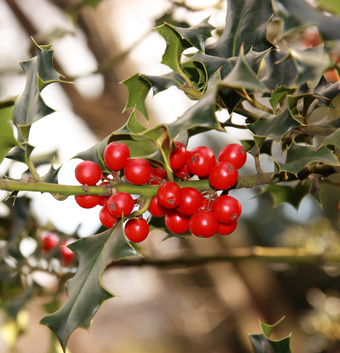Poisoning mistletoe and Holly
 Mistletoe and Holly are two plants that are toxic when ingested by a pet. Young animals, especially players, are tempted to chew any plant left within their reach.
Mistletoe and Holly are two plants that are toxic when ingested by a pet. Young animals, especially players, are tempted to chew any plant left within their reach.
MISTLETOE POISONING
The mistletoe balls contain a substance called viscotoxine which causes, a few hours after its absorption by an animal, different types of disorders:
– The irritation caused by the toxin on the digestive mucous membranes (of the mouth, of the stomach…) will be accompanied by a very important salivation and vomiting. Diarrhea may also be observed a few hours after ingestion of berries.
– The viscotoxine also causes a decrease in blood pressure at the origin of a serious hypotension
– Finally, of nervous disorders can be seen: dilated pupils, increase sensitivity of the animal (which excessively reacts to the slightest little stimulus), or even approach abnormal (with incoordination in movements and balance disorders)
The symptoms are variable depending on the dose ingested and the size of the animal. A massive ingestion of mistletoe may be deadly.
There are no antidote against the viscotoxine.
If you have seen your pet ingest mistletoe berries or if you suspect of having swallowed, make you immediately to your veterinarian. If the gui comes to be swallowed, the veterinarian will make it vomit or proceed to gastric lavage reduce the quantity of product present in the body. The administration of activated charcoal may, She also, limit the doses of toxin absorbed.
Finally, each symptom will be treated (support of heart function, fight against nervous disorders, support of liver and kidney function…)
The toxicity of mistletoe is not negligible, It is appropriate to monitor your pet and make sure that it has access or directly to the plant, or arrays that could fall to the ground.
POISONING BY HOLLY
 Just like those of the gui, Holly berries are toxic. The Holly leaves also exhibit some toxicity but are rarely eaten because of the presence of the Quills on their surface.
Just like those of the gui, Holly berries are toxic. The Holly leaves also exhibit some toxicity but are rarely eaten because of the presence of the Quills on their surface.
The symptoms observed after the absorption of Holly are those of a buccal irritation (important salivation), a irritation of the digestive tract (vomiting, diarrhea, abdominal pain) and any nervous disorders If berries were ingested in very large quantity.
The toxicity of Holly is less significant than the gui and its absorption is rarely fatal.
There is no specific antidote against intoxication to Holly and the treatment will be, There still, symptomatic (antivomitif, antidiarrheal, rehydration…)
§
Mistletoe and Holly, very present in our homes in these periods of holidays, are toxic to our pets. It must be absolutely prevent access to these plants to our companions.
